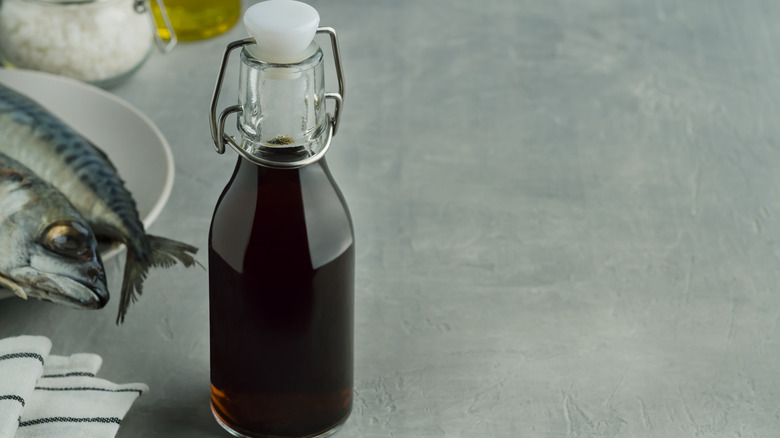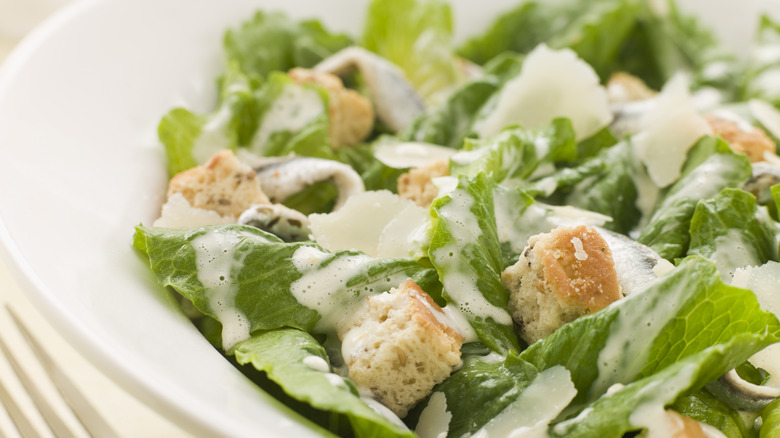Forget Anchovies: Fish Sauce Will Take Your Caesar Salad To The Next Level
Doesn't it always seem like Caesar salad is better at a restaurant than it is at home? Sure, you can cut up romaine lettuce and toss it with either homemade or store-bought dressing and some croutons and get something similar to what you'd get at a trendy bistro. The difference, however, comes down to the ingredients, especially in the dressing. Caesar salad dressing from restaurants is almost always made with anchovies, which gives it a deep, rich boost of umami flavor. You don't need to open up a tin of anchovies to get that same flavor in your homemade salad, however, and you don't even need to make your own dressing. All you need to boost your dressing to taste more like what you'd get in a restaurant is a couple of dashes of fish sauce.
Fish sauce is a staple in most Asian pantries and is almost always made with anchovies. Just like anchovy filets, it imparts a rich, savory flavor to any recipe. If you have a bottle in your fridge, all it takes is a few shakes into the salad bowl when you toss your dressing and greens to take your Caesar to the next level.
Fish sauce is closer to the original Caesar recipe
These days you can get a Caesar salad pretty much everywhere, but the original recipe has only been around since 1924. It was invented by Cesare Cardini, who was an Italian immigrant who lived in San Diego and ran a restaurant in Tijuana, Mexico. Interestingly, although most recipes for Caesar Salad today include anchovies or anchovy paste, the original salad was made with Worcestershire sauce, according to UCHealth. Worcestershire gets its salty, savory flavor from (you guessed it) anchovies, so you might say that it's actually a type of fish sauce in itself.
Fish sauce is super common in Asian cuisine, but it's been around since the Roman and Greek empires. It's made by salting and fermenting flavorful fish and collecting the concentrated juice, which is chock full of glutamate. Glutamate is a naturally occurring amino acid, and it gives foods like parmesan cheese, milk, eggs, mushrooms, and nuts a savory, meaty quality, which we call "umami." When you add a few drops of fish sauce to your salad dressing, you don't necessarily taste fish, but instead, you'll get a satisfying, savory flavor that balances out the dressing. Many professional kitchens make Caesar dressing in a blender or food processor and simply puree an anchovy or two in the process to get that umami flavor. Fish sauce, however, has more of a concentrated flavor than an anchovy filet alone, so it will make your dressing and salad a little more complex and interesting.
Fish sauce is versatile
If you want to use fish sauce to take your next Caesar salad up a notch, you can either make your own dressing from scratch or you can doctor up some store-bought dressing.
If you want to make your own dressing, substitute the anchovies in any recipe with fish sauce. Since anchovy filets are solid and fish sauce is liquid, don't substitute it one-for-one with anchovies because they aren't the same and you could end up with a very fishy, runny dressing. Fish sauce is concentrated, so use only ½ a teaspoon of fish sauce in place of every whole anchovy filet.
If you're making a salad with store-bought dressing, all you need to do is add a dash or two to taste for every salad you plan to make. It's a good idea to taste your dressing first and read the ingredients label to see if it already contains anchovy so that you don't go overboard with the umami.
The nice thing about swapping fish sauce for anchovies from a pantry perspective is that fish sauce has a very long shelf life, and it's more versatile than an open tin of anchovies. If you've ever made something that calls for one or two anchovy filets, for example, there's a good chance the rest of the tin will eventually get thrown away. Fish sauce, on the other hand, is great in stir fry, pad thai, and more. Keep a bottle of it around and you'll always have a secret weapon for all kinds of dishes, especially Caesar salad.


